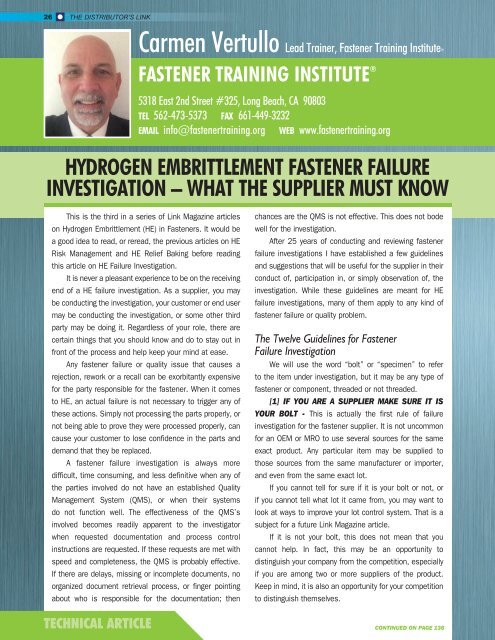FALL 2016
Distributor's Link Magazine Fall Issue 2016 / Vol 39 No4
Distributor's Link Magazine Fall Issue 2016 / Vol 39 No4
You also want an ePaper? Increase the reach of your titles
YUMPU automatically turns print PDFs into web optimized ePapers that Google loves.
26<br />
THE DISTRIBUTOR’S LINK<br />
Carmen Vertullo Lead Trainer, Fastener Training Institute®<br />
FASTENER TRAINING INSTITUTE ®<br />
5318 East 2nd Street #325, Long Beach, CA 90803<br />
TEL 562-473-5373 FAX 661-449-3232<br />
EMAIL info@fastenertraining.org WEB www.fastenertraining.org<br />
HYDROGEN EMBRITTLEMENT FASTENER FAILURE<br />
INVESTIGATION – WHAT THE SUPPLIER MUST KNOW<br />
This is the third in a series of Link Magazine articles<br />
on Hydrogen Embrittlement (HE) in Fasteners. It would be<br />
a good idea to read, or reread, the previous articles on HE<br />
Risk Management and HE Relief Baking before reading<br />
this article on HE Failure Investigation.<br />
It is never a pleasant experience to be on the receiving<br />
end of a HE failure investigation. As a supplier, you may<br />
be conducting the investigation, your customer or end user<br />
may be conducting the investigation, or some other third<br />
party may be doing it. Regardless of your role, there are<br />
certain things that you should know and do to stay out in<br />
front of the process and help keep your mind at ease.<br />
Any fastener failure or quality issue that causes a<br />
rejection, rework or a recall can be exorbitantly expensive<br />
for the party responsible for the fastener. When it comes<br />
to HE, an actual failure is not necessary to trigger any of<br />
these actions. Simply not processing the parts properly, or<br />
not being able to prove they were processed properly, can<br />
cause your customer to lose confidence in the parts and<br />
demand that they be replaced.<br />
A fastener failure investigation is always more<br />
difficult, time consuming, and less definitive when any of<br />
the parties involved do not have an established Quality<br />
Management System (QMS), or when their systems<br />
do not function well. The effectiveness of the QMS’s<br />
involved becomes readily apparent to the investigator<br />
when requested documentation and process control<br />
instructions are requested. If these requests are met with<br />
speed and completeness, the QMS is probably effective.<br />
If there are delays, missing or incomplete documents, no<br />
organized document retrieval process, or finger pointing<br />
about who is responsible for the documentation; then<br />
TECHNICAL ARTICLE<br />
chances are the QMS is not effective. This does not bode<br />
well for the investigation.<br />
After 25 years of conducting and reviewing fastener<br />
failure investigations I have established a few guidelines<br />
and suggestions that will be useful for the supplier in their<br />
conduct of, participation in, or simply observation of, the<br />
investigation. While these guidelines are meant for HE<br />
failure investigations, many of them apply to any kind of<br />
fastener failure or quality problem.<br />
The Twelve Guidelines for Fastener<br />
Failure Investigation<br />
We will use the word “bolt” or “specimen” to refer<br />
to the item under investigation, but it may be any type of<br />
fastener or component, threaded or not threaded.<br />
[1] IF YOU ARE A SUPPLIER MAKE SURE IT IS<br />
YOUR BOLT - This is actually the first rule of failure<br />
investigation for the fastener supplier. It is not uncommon<br />
for an OEM or MRO to use several sources for the same<br />
exact product. Any particular item may be supplied to<br />
those sources from the same manufacturer or importer,<br />
and even from the same exact lot.<br />
If you cannot tell for sure if it is your bolt or not, or<br />
if you cannot tell what lot it came from, you may want to<br />
look at ways to improve your lot control system. That is a<br />
subject for a future Link Magazine article.<br />
If it is not your bolt, this does not mean that you<br />
cannot help. In fact, this may be an opportunity to<br />
distinguish your company from the competition, especially<br />
if you are among two or more suppliers of the product.<br />
Keep in mind, it is also an opportunity for your competition<br />
to distinguish themselves.<br />
CONTINUED ON PAGE 136

















